Abstract
1. Chronotropic dose-response curves (non-cumulative) for β-adrenoceptive antagonists were constructed from results in rats anaesthetized with pentobarbitone and depleted of catecholamines by pre-treatment with syrosingopine.
2. Depletion of catecholamines lowered resting heart rate and reduced the threshold to the chronotropic action of isoprenaline by about 50%. Eight β-adrenoceptive antagonists produced a dose-dependent chronotropic response but the maximum response was in all cases smaller than that obtained with isoprenaline. The order of activity was dichloroisoprenaline>LB 46>practolol>INPEA>oxprenolol>pronethalol>alprenolol>I.C.I. 45,763 (Kö 592). Propranolol and sotalol were without significant activity. The duration of the chronotropic response to the antagonists was more prolonged than that to isoprenaline. Propranolol caused a parallel shift to the right of the dose-response curves for the agonist effects of the antagonists.
3. Estimation of β-adrenoceptor blocking activity in anaesthetized cats gave an order of activity dissimilar to that found for maximum agonist responses: LB 46 > oxprenolol > alprenolol > propranolol > I.C.I. 45,763 > practolol > dichloroisoprenaline > sotalol > INPEA > pronethalol.
4. Consideration of chemical structure and physico-chemical properties did not explain the differences between the agonist activities of the adrenoceptive antagonists.
Full text
PDF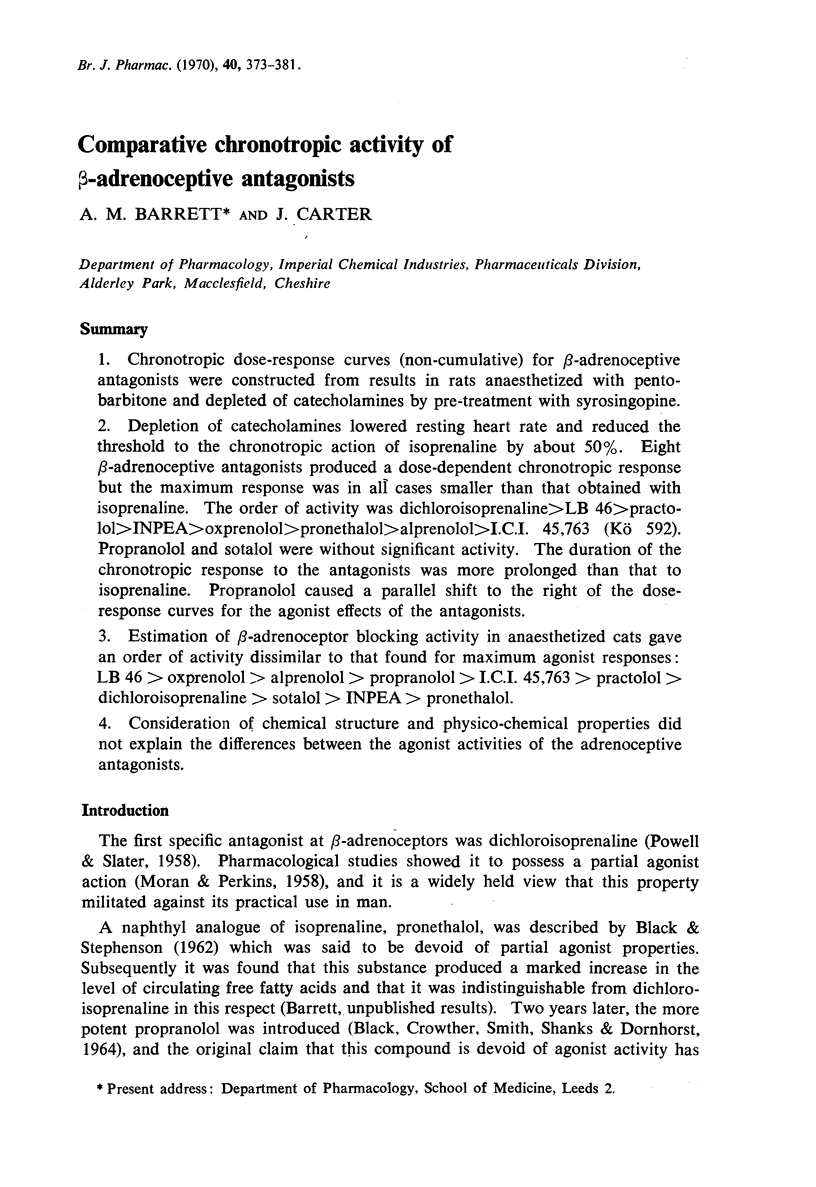



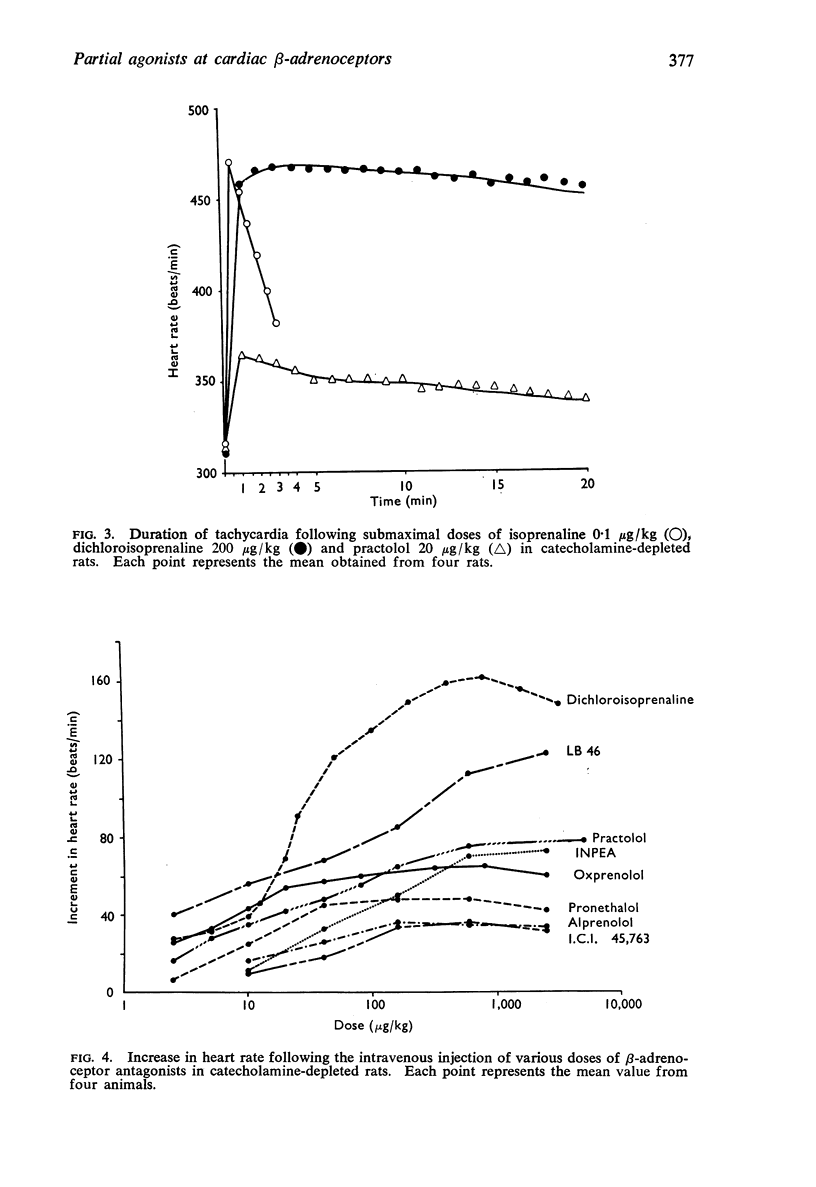
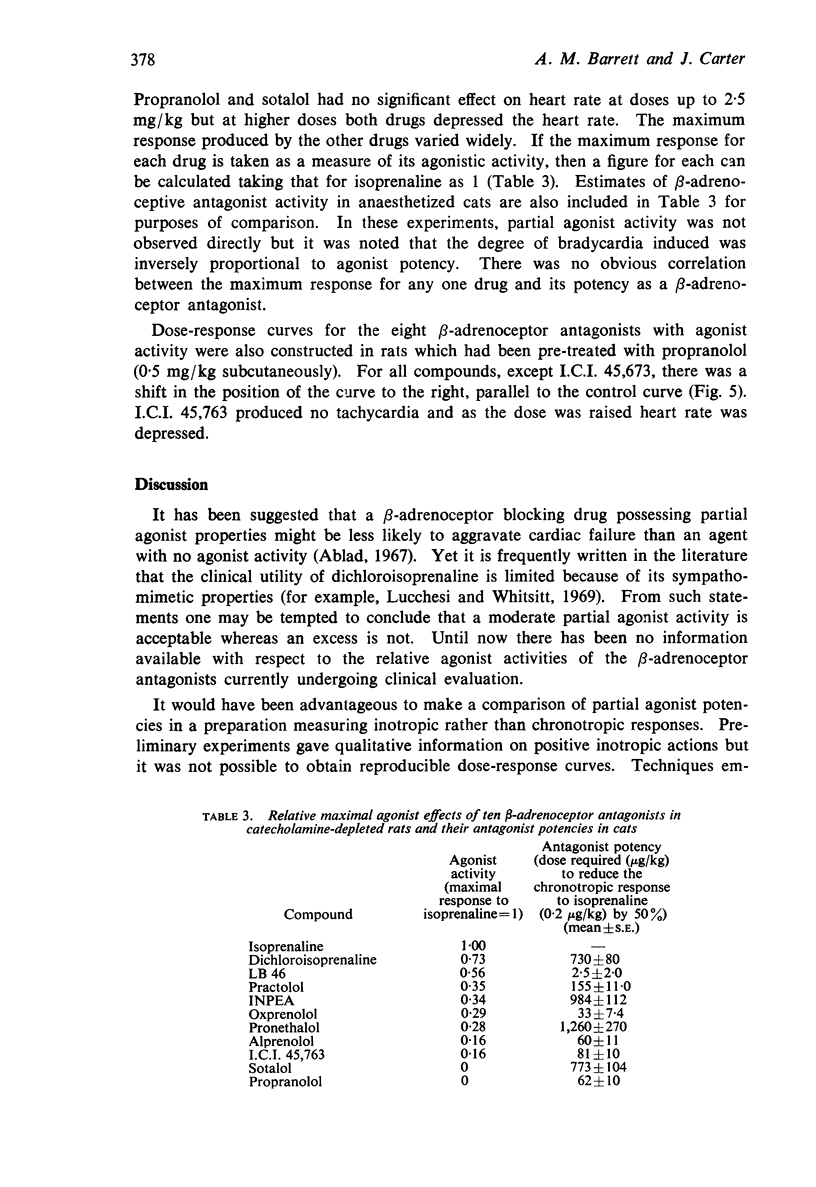
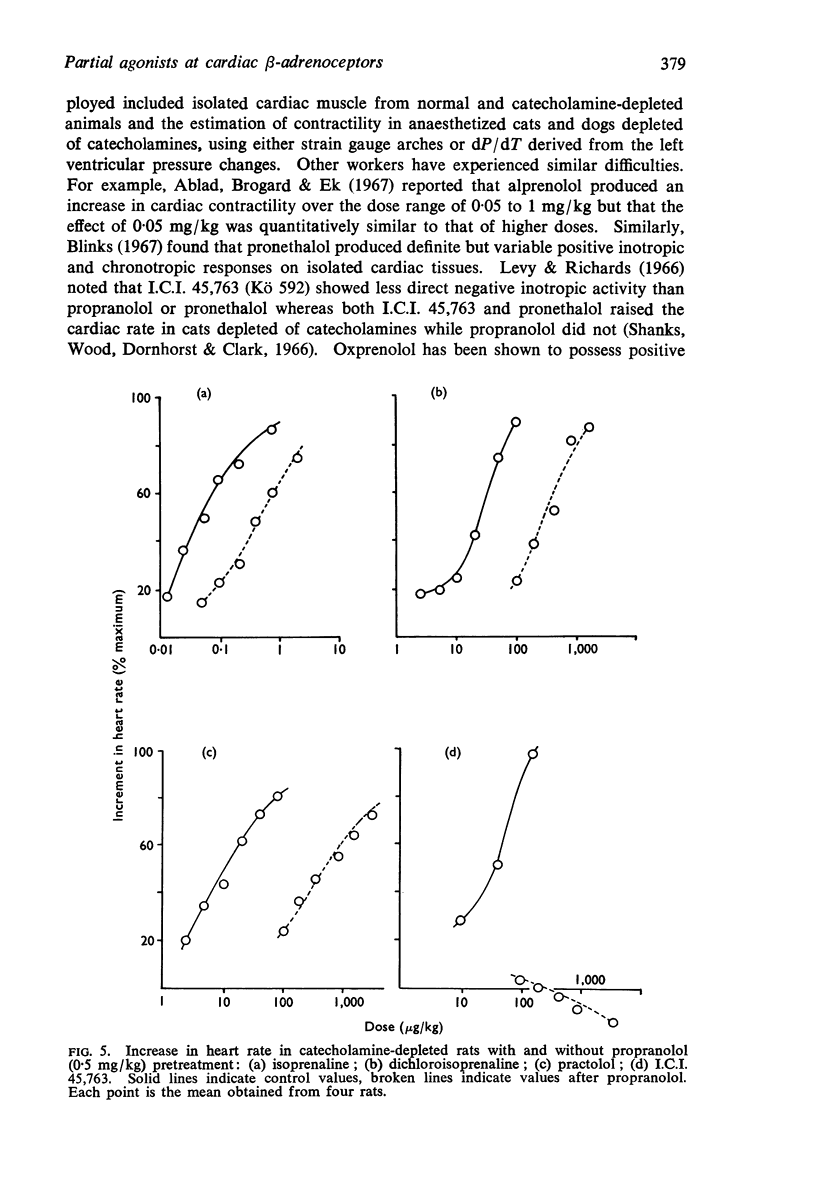
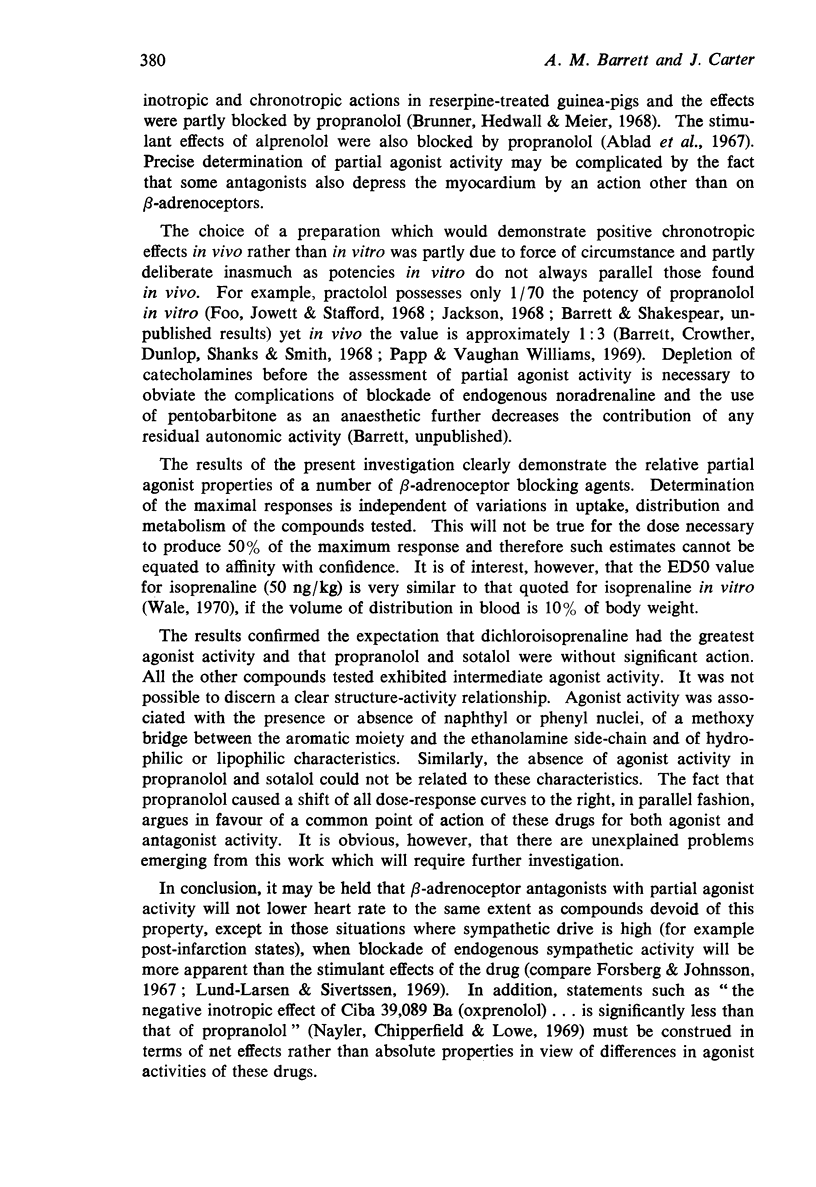
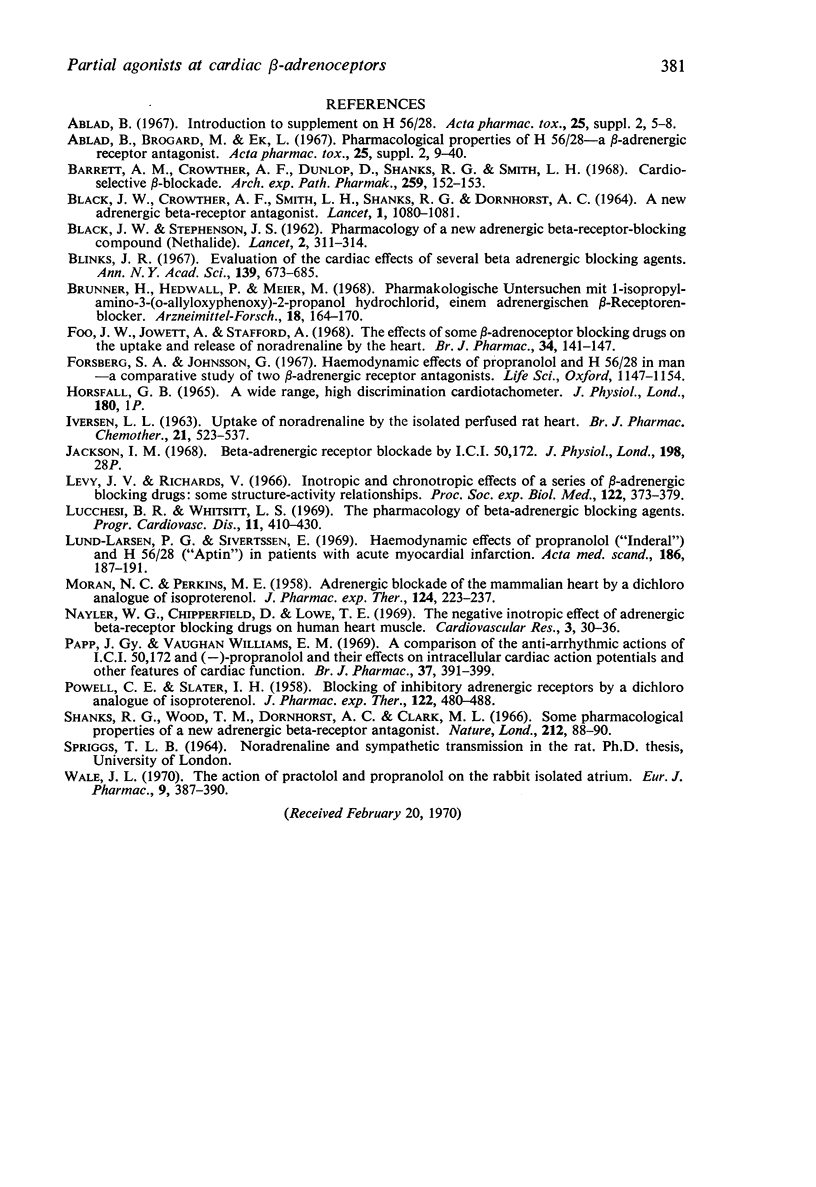
Selected References
These references are in PubMed. This may not be the complete list of references from this article.
- Ablad B., Brogård M., Ek L. Pharmacological properties of H 56-28--a beta-adrenergic receptor antagonist. Acta Pharmacol Toxicol (Copenh) 1967;25:9–40. [PubMed] [Google Scholar]
- BLACK J. W., CROWTHER A. F., SHANKS R. G., SMITH L. H., DORNHORST A. C. A NEW ADRENERGIC BETARECEPTOR ANTAGONIST. Lancet. 1964 May 16;1(7342):1080–1081. doi: 10.1016/s0140-6736(64)91275-9. [DOI] [PubMed] [Google Scholar]
- BLACK J. W., STEPHENSON J. S. Pharmacology of a new adrenergic beta-receptor-blocking compound (Nethalide). Lancet. 1962 Aug 18;2(7251):311–314. doi: 10.1016/s0140-6736(62)90103-4. [DOI] [PubMed] [Google Scholar]
- Barrett A. M., Crowther A. F., Dunlop D., Shanks R. G., Smith L. H. Cardio-selective beta-blockade. Naunyn Schmiedebergs Arch Exp Pathol Pharmakol. 1968;259(2):152–153. doi: 10.1007/BF00537746. [DOI] [PubMed] [Google Scholar]
- Blinks J. R. Evaluation of the cardiac effects of several beta adrenergic blocking agents. Ann N Y Acad Sci. 1967 Feb 10;139(3):673–685. doi: 10.1111/j.1749-6632.1967.tb41237.x. [DOI] [PubMed] [Google Scholar]
- Brunner H., Hedwall P. R., Meier M. Pharmakologische Untersuchungen mit 1-Isopropylamono-3-(o-allyloxyphenoxy)-2-propanol-hydrochlorid, einem adrenergischen beta-Receptorenblocker. Arzneimittelforschung. 1968 Feb;18(2):164–170. [PubMed] [Google Scholar]
- Foo J. W., Jowett A., Stafford A. The effects of some beta-adrenoreceptor blocking drugs on the uptake and release of noradrenaline by the heart. Br J Pharmacol. 1968 Sep;34(1):141–147. doi: 10.1111/j.1476-5381.1968.tb07957.x. [DOI] [PMC free article] [PubMed] [Google Scholar]
- Forsberg S. A., Johnsson G. Hemodynamic effects of propranolol and H 56/28 in man. A comparative study of two beta-adrenergic receptor antagonists. Life Sci. 1967 Jun 1;6(11):1147–1154. doi: 10.1016/0024-3205(67)90196-8. [DOI] [PubMed] [Google Scholar]
- IVERSEN L. L. THE UPTAKE OF NORADRENALINE BY THE ISOLATED PERFUSED RAT HEART. Br J Pharmacol Chemother. 1963 Dec;21:523–537. doi: 10.1111/j.1476-5381.1963.tb02020.x. [DOI] [PMC free article] [PubMed] [Google Scholar]
- Levy J. V., Richards V. Inotropic and chronotropic effects of a series of beta-adrenergic blocking drugs: some structure-activity relationships. Proc Soc Exp Biol Med. 1966 Jun;122(2):373–379. doi: 10.3181/00379727-122-31138. [DOI] [PubMed] [Google Scholar]
- Lucchesi B. R., Whitsitt L. S. The pharmacology of beta-adrenergic blocking agents. Prog Cardiovasc Dis. 1969 Mar;11(5):410–430. doi: 10.1016/0033-0620(69)90029-2. [DOI] [PubMed] [Google Scholar]
- Lund-Larsen G., Sivertssen E. Hemodynamic effects of propranolol (Inderal) and H 56-28 (Aptin) in patients with acute myocardial infarction. A comparative study. Acta Med Scand. 1969 Sep;186(3):187–191. [PubMed] [Google Scholar]
- MORAN N. C., PERKINS M. E. Adrenergic blockade of the mammalian heart by a dichloro analogue of isoproterenol. J Pharmacol Exp Ther. 1958 Nov;124(3):223–237. [PubMed] [Google Scholar]
- Nayler W. G., Chipperfield D., Lowe T. E. The negative inotropic effect of adrenergic betareceptor blocking drugs on human heart muscle. Cardiovasc Res. 1969 Jan;3(1):30–36. doi: 10.1093/cvr/3.1.30. [DOI] [PubMed] [Google Scholar]
- POWELL C. E., SLATER I. H. Blocking of inhibitory adrenergic receptors by a dichloro analog of isoproterenol. J Pharmacol Exp Ther. 1958 Apr;122(4):480–488. [PubMed] [Google Scholar]
- Papp J. G., Williams E. M. A comparison of the anti-arrhythmic actions of I.C.I. 50172 and (--)-propranolol and their effects on intracellular cardiac action potentials and other features of cardiac function. Br J Pharmacol. 1969 Oct;37(2):391–399. doi: 10.1111/j.1476-5381.1969.tb10576.x. [DOI] [PMC free article] [PubMed] [Google Scholar]
- Shanks R. G., Wood T. M., Dornhorst A. C., Clark M. L. Some pharmacological properties of a new adrenergic beta-receptor antagonist. Nature. 1966 Oct 1;212(5057):88–90. doi: 10.1038/212088a0. [DOI] [PubMed] [Google Scholar]
- Wale J. The action of practolol and propranolol on the rabbit isolated atrium. Eur J Pharmacol. 1970 Mar;9(3):387–390. doi: 10.1016/0014-2999(70)90241-4. [DOI] [PubMed] [Google Scholar]


